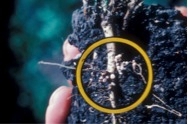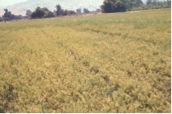When is nitrogen fertilization of alfalfa beneficial? Almost never!
Nitrogen (N) fertilizer is generally not required for alfalfa production since alfalfa can obtain its own N from N-fixing nodules (Figure 1). Alfalfa fixes most (70-90%) of its N needs from the air through Rhizobium bacteria residing in alfalfa root nodules (Figure 1). Since 78% of our air consists of nitrogen gas, this supply of ‘free fertilizer’ is inexhaustible. A recent unpublished UC Davis-CSU Fresno study showed 90% of N in alfalfa originated from the atmosphere -- but less when soil N levels were high, for example, in manured fields.
Although there have been some reports of yield and forage quality increases with N applications to alfalfa, actual research results have been mixed. That is, sometimes there is a modest yield response by alfalfa to N but most of the time, there isn’t. There may be slight increases in Crude Protein associated with N fertilizer, but these are usually due to presence of non-protein N. Non-protein nitrogen in the plant is considered detrimental by animal nutritionists, since it requires energy to metabolize this excess N. Grassy weeds are also much more of a problem in N-fertilized alfalfa fields.
These are the reasons that nearly all U.S. universities do not recommend N fertilizers for alfalfa under most circumstances. However, there are certain situations when nitrogen fertilizer applications to alfalfa are thought to be warranted. What are these, and is N fertilizer really justified in all such situations?
- Seedling alfalfa – applications of small amounts of N with phosphorus as a starter fertilizer is a common practice. Nitrogen-fixing nodules may require a period of 2 to 4 weeks to develop and sometimes up to 3 cuttings to be most effective. During this establishment phase, the plant relies on soil and fertilizer nitrogen. If the soil contains more than 15 ppm available nitrogen at planting time, the soil can usually supply the needs of the crop before nodulation becomes established; thus nitrogen fertilizer is not required. But in situations with depleted soil N, a small amount of N fertilizers at seeding can actually stimulate nodule formation. But don’t overdo it! Nitrogen fertilizer rates ranging from 20 to 70 pounds per acre have been reported to inhibit nodule formation. Typically, the amounts of N contained in (for example) 11-52-0 fertilizers applied at planting are sufficient.
- Cold soils – Responses to nitrogen fertilizer have been reported in cold soils, particularly those low in soil nitrogen. The soil temperature range for nitrogen fixation is about 40 to 85°F, with an optimum range of 68 to 78°F. When soils are very cold, sometimes small amounts of N fertilizers can stimulate growth, enabling the plant to re-establish nodulation and normal N2 fixation as conditions warm up.
- Hot soils – the possible negative effect of high temperatures on nitrogen fixation has been suggested as a cause for decreased yields during the summer. Surface soil temperature can easily exceed air temperatures, and soil is exposed in alfalfa after each cutting. However, soil temperature moderates greatly 2 to 4 inches below the soil surface and most of the nodules are found between 3 and 12 inches below the soil surface. Heat can have a negative effect on plant growth in general, not necessarily on nodulation per-se. If heat, cracking soils, salt, and stress have compromised plant growth, N fertilizers won’t necessarily fix that.
- Waterlogged or shallow soils – Proper root growth requires air to function, and waterlogging, especially combined with a shallow soil, is detrimental to nitrogen fixation as a result of poor root growth. However, research in California documented that N applications in saturated soils did not enhance alfalfa yields as the plants needed air to grow, not N. If you see yellowed, seemingly N-starved alfalfa plants after wet periods, just wait for sunnier, drier conditions—N fertilizers won’t really help.
- Poorly-nodulated fields - If you see overall yellowing of foliage in an otherwise normal field, with just an occasional green plant, start digging up plants to see if nodulation is a problem. Nodules are small polyps on the roots, which have a reddish color inside when broken. If you don’t see nodules (be careful-they fall off easily), or if the nodules are not reddish, that’s a sign of poor nodulation. This could be because of lack of the proper inoculum (alfalfa specific: Rhizobium meliloti, available commercially), or because of low pH or micronutrients (for example, molybdenum), or other factors. What to do? Some short-term N fertilizers will be beneficial, but more importantly, re-inoculate the field with water-run inoculum applications to re-establish nodules. Also correct for soil factors such as pH.
- Molybdenum deficiency – Molybdenum (Mo or “moly”) is essential for nodulation and assimilation of biologically fixed nitrogen in the plant. Therefore, molybdenum deficiency in alfalfa may lead to nitrogen deficiency, and molybdenum deficient plants respond to nitrogen fertilizer. Add Moly to correct a deficiency.
- Low pH soils – Though not a problem for most of our soils, alfalfa requires a pH of 6.5 or above for optimum nitrogen fixation. If you have a pH below this level, consider applications of lime.
- Alfalfa-grass mixtures – Nitrogen fertilizer is usually recommended for mixtures of alfalfa with a grass in order to realize the yield potential of the grass. However, although this maximizes yields, it also tends to favor the grass in mixtures, so the alfalfa will likely be crowded out to a greater degree.
- Compromised root systems - Factors such as excessive root disease, root pruning due to cracking soils, winter injury, water-logging (Figure 2), short cutting cycles, lack of proper fertilization, deficit irrigation, or other issues can result in highly compromised roots, particularly loss of fine root hairs, which are the ‘powerhouses’ of nutrient absorption. In these cases, applications of small amounts of N fertilizers may improve short-term growth so that the roots can begin to re-generate. However, this should be done in combination with other practices, such as extending the harvest schedules, good drainage, or paying more attention to irrigation or fertilization practices. Alfalfa has an excellent capacity to recover from severe stresses, but once roots have sufficiently recovered, N-fertilization should cease. Examine the roots to assure nodulation is re-established.
In summary: There are some growers who routinely apply large amounts of N fertilizers to alfalfa. This has been especially true in desert soils. In our view, this is a mistake. The science doesn’t support it. It’s expensive, requires fossil fuels, and isn’t necessary. If nodulation (infection with beneficial bacteria which fix nitrogen) is not successful, try harder to solve that problem. It could be an issue of making sure that viable bacteria of the right species and strain is applied successfully to a field (and re-applied if necessary), correcting a soil factor such as low pH, salt, or low molybdenum, or improving irrigation practices so that roots are not as compromised. Some desert growers routinely apply N fertilizers, but if they examine the economics of this practice, it’s rarely beneficial. In rare circumstances, application of modest amounts of N to ‘jump start’ alfalfa growth can assist if the roots are compromised, the plants are young, the soils are cold, or other stresses exist, but this should be looked on as only a short-term mitigation measure, not a routine practice.
Figure 1. Rhizobium bacteria reside in nodules in alfalfa roots that provide nitrogen to the plant, which means no N fertilizers are normally needed. However, there are some rare circumstances where N fertilzers may help ‘jump start’ the crop temporarily.
Figure 2. This field showed a yellow, N-starved appearance. But this was the result of excess flooding and lack of oxygen to the roots. Only drainage and better growing conditions will correct this problem.

